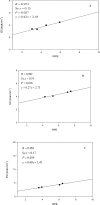Can Energy Cost During Low-Intensity Resistance Exercise be Predicted by the OMNI-RES Scale?
- PMID: 23486188
- PMCID: PMC3588892
- DOI: 10.2478/v10078-011-0062-5
Can Energy Cost During Low-Intensity Resistance Exercise be Predicted by the OMNI-RES Scale?
Abstract
The aim of the present study was to assess the precision of the OMNI-RES scale to predict energy cost (EC) at low intensity in four resistance exercises (RE). 17 male recreational body builders (age = 26.6 ± 4.9 years; height = 177.7 ± 0.1 cm; body weight = 79.0 ± 11.1 kg and percent body fat = 10.5 ± 4.6%) served as subjects. Initially tests to determine 1RM for four resistance exercises (bench press, half squat, lat pull down and triceps extension) were administered. Subjects also performed resistance exercise at 12, 16, 20, and 24% of 1RM at a rate of 40 bpm until volitional exhaustion. Oxygen uptake (VO2) and rate of perceived exertion (RPE) using the OMNI-RES were obtained during and after all RE. EC was calculated using VO2 and the caloric values of VO2 for non-protein RER. Regression analyses were performed for every RE, using EC as the dependent and RPE as the predictor variable. The triceps extension, lat pull down and bench press, RPE correlated strongly with EC (R > 0.97) and predicted EC with a error of less than 0.2 kcal.min(-1). In conclusion, RPE using the OMNI-RES scale can be considered as an accurate indicator of EC in the bench press, lat pull down and triceps extension performed by recreational bodybuilders, provided lower intensities are used (up to 24% of 1-RM) and provided each set of exercise is performed for the maximal sustainable duration. It would be interesting in future studies to consider having the subjects exercise at low intensities for longer durations than those in the present study.
Keywords: oxygen uptake, rate of perceived exertion; resistance exercise.
Figures
Similar articles
-
Are wearable heart rate measurements accurate to estimate aerobic energy cost during low-intensity resistance exercise?PLoS One. 2019 Aug 22;14(8):e0221284. doi: 10.1371/journal.pone.0221284. eCollection 2019. PLoS One. 2019. PMID: 31437191 Free PMC article.
-
Aerobic and Anaerobic Energy During Resistance Exercise at 80% 1RM.J Hum Kinet. 2011 Sep;29A:69-74. doi: 10.2478/v10078-011-0061-6. Epub 2011 Oct 4. J Hum Kinet. 2011. PMID: 23487002 Free PMC article.
-
Energy cost of isolated resistance exercises across low- to high-intensities.PLoS One. 2017 Jul 24;12(7):e0181311. doi: 10.1371/journal.pone.0181311. eCollection 2017. PLoS One. 2017. PMID: 28742112 Free PMC article.
-
Effects of exercise intensity on rating of perceived exertion during a multiple-set resistance exercise session.J Strength Cond Res. 2012 Feb;26(2):466-72. doi: 10.1519/JSC.0b013e31822602fa. J Strength Cond Res. 2012. PMID: 22233796
-
Oxygen uptake and heart rate kinetics after different types of resistance exercise.J Hum Kinet. 2014 Oct 10;42:235-44. doi: 10.2478/hukin-2014-0077. eCollection 2014 Sep 29. J Hum Kinet. 2014. PMID: 25414756 Free PMC article.
Cited by
-
Relationship between the rating of perceived exertion scale and the load intensity of resistance training.Strength Cond J. 2018 Apr;40(2):94-109. doi: 10.1519/SSC.0000000000000373. Strength Cond J. 2018. PMID: 29674945 Free PMC article.
-
Convergent Validity of Ratings of Perceived Exertion During Resistance Exercise in Healthy Participants: A Systematic Review and Meta-Analysis.Sports Med Open. 2022 Jan 8;8(1):2. doi: 10.1186/s40798-021-00386-8. Sports Med Open. 2022. PMID: 35000021 Free PMC article.
References
-
- Baechle TR, Earle RW. National Strength Conditioning Association (U.S.). Essentials of strength training and conditioning. 2nd ed. Champaign, Ill: Human Kinetics; 2000.
-
- Borg GA. Psychophysical bases of perceived exertion. Med Sci Sports Exerc. 1982;14(5):377–81. - PubMed
-
- Gearhart RF, Goss FL, Lagally KM, Jakicic JM, Gallagher J, Gallagher KI, et al. Ratings of perceived exertion in active muscle during high-intensity and low-intensity resistance exercise. J Strength Cond Res. 2002;16(1):87–91. - PubMed
-
- Haltom RW, Kraemer RR, Sloan RA, Hebert EP, Frank K, Tryniecki JL. Circuit weight training and its effects on excess postexercise oxygen uptake. Med Sci Sports Exerc. 1999;31(11):1613–8. - PubMed
-
- Hetzler RK, Seip RL, Boutcher SH, Pierce E, Snead D, Weltman A. Effect of exercise modality on ratings of perceived exertion at various lactate concentrations. Medicine Med Sci Sports Exerc. 1991;23(1):88–92. - PubMed
LinkOut - more resources
Full Text Sources
Research Materials
Miscellaneous


